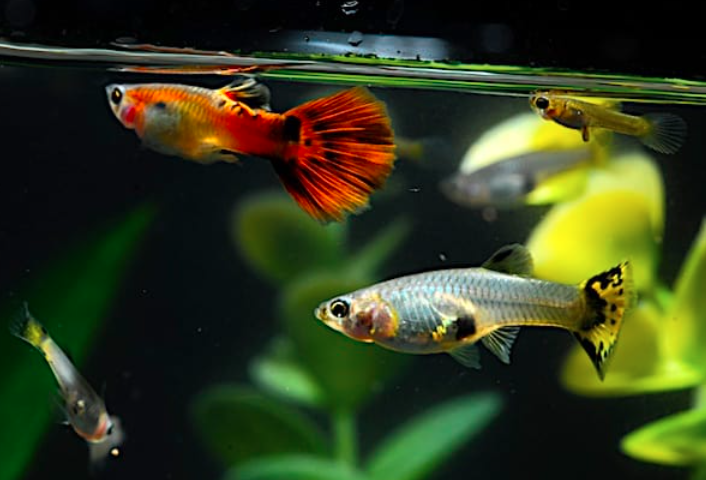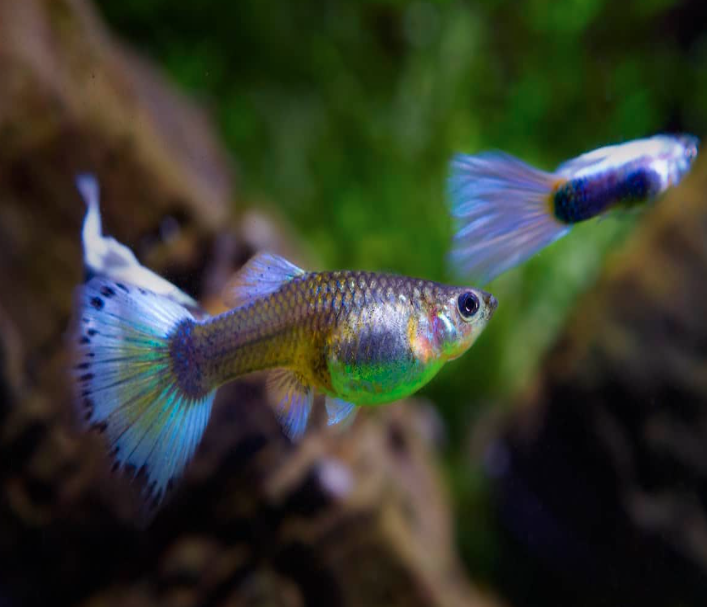Introduction To Male vs Female Guppies
When it comes to Male vs Female Guppies, it’s important to understand the unique differences between them. These differences are not just about physical appearance, but also about their behaviour, size, and role in the aquarium. Whether you’re a seasoned fish keeper or new to the hobby, knowing these distinctions can help you better care for your guppies, enhance their environment, and possibly even breed them successfully.
Let’s dive into the fascinating world of Male vs Female Guppies and discover what sets them apart.

Physical Differences Between Male and Female Guppies
One of the most noticeable distinctions between Male and Female Guppies is their physical appearance. Males are generally smaller and more colourful, with vibrant hues of blue, red, yellow, and orange. These colours are designed to attract females and signal their fitness as potential mates. The males also have an elongated, slender body shape that allows them to move quickly and dart around the tank in search of mates.
In contrast, female guppies tend to be larger and more subdued in colour. They are typically greyish or silver with hints of pastel colours. Their larger size helps them carry and protect the developing fry (baby guppies) once they become pregnant. The body shape of females is rounder, designed to accommodate their internal reproductive system.
When you observe them swimming, you’ll notice the males darting around more actively, trying to impress the females with their bright colours and energetic movements. This difference in behaviour is just another example of how Male vs Female Guppies vary.
Behavioural Differences Between Males and Females
While Male vs Female Guppies have noticeable physical differences, their behaviours also set them apart. Males are often seen performing display rituals to attract females. They can vibrate their fins, swim in tight circles, and even display their colours in a way that catches the attention of the females.
Females, on the other hand, tend to be more passive. They may show interest in a male, but they are not usually as proactive in chasing after potential mates. Instead, females wait for the males to come to them. Once a male successfully courts a female, he may engage in mating dances, which can last for several minutes.
The dynamics of Male vs Female Guppies in terms of behaviour are driven by reproduction. Males are eager to mate and will display their best traits to impress females, while females are more selective, looking for the most vibrant and healthiest males to mate with.
Size Differences: Male vs Female Guppies
Another noticeable contrast between Male vs Female Guppies is their size. Males are usually around 2.5 to 3 centimetres in length, while females can grow to be up to 6 centimetres long. This size difference becomes particularly important when it comes to breeding, as the larger female carries and protects the developing fry.
Females may also appear bulkier when they are pregnant, as they carry the developing fry in their abdomen. Their size allows them to produce a larger number of fry at once, sometimes up to 30 or more, depending on the female’s age and health.
If you’re keeping both male and female guppies in your aquarium, you’ll notice the size difference right away. The males are sleek and small, darting around the tank, while the females appear bulkier and more passive.
Colouration Differences: Why Males Are More Vibrant
When it comes to the colouration of Male vs Female Guppies, the males steal the show. Male guppies display a stunning array of colours, patterns, and markings, all aimed at attracting females. These bright colours act as a visual signal of the male’s health and genetic quality, which the females use to make a selection for mating.
Females, on the other hand, have a more muted appearance. Their colours are typically pale, and they do not have the same intricate patterns and hues that males display. The lack of vibrant colours in females is an evolutionary trait that ensures they do not stand out in the wild, where bright colours can attract predators.
For any fish keeper, it’s easy to tell the Male vs Female Guppies based on their colouration. If you’re looking for a showy, colourful addition to your tank, the males are certainly the ones to focus on.

Reproductive Roles: Male vs Female Guppies
When it comes to reproduction, Male vs Female Guppies play very different roles. The male’s job is to fertilise the female’s eggs, which he does through a specialised organ called a gonopodium. This organ allows the male to transfer sperm directly into the female’s body, where fertilisation takes place.
Females, on the other hand, are the ones who carry the fertilised eggs and eventually give birth to live fry. Female guppies are capable of storing sperm for weeks, sometimes even months, after mating. This means that one successful mating event can lead to multiple batches of fry being born without the need for the female to mate again.
This reproductive strategy is crucial for ensuring the survival and population growth of guppies in their natural habitat. For those breeding guppies in an aquarium, understanding the reproductive roles of Male vs Female Guppies is key to managing their populations effectively.
Lifespan: How Long Do Male and Female Guppies Live?
In terms of lifespan, Male vs Female Guppies also differ slightly. Males typically live for around 1.5 to 2 years, while females can live a bit longer, sometimes up to 3 years, particularly if they are well cared for in a healthy environment.
The shorter lifespan of males is partly due to their high activity levels and the energy they expend in mating rituals. Females, being less active and larger, tend to have a slightly longer life expectancy.
To maximise the lifespan of your guppies, it’s important to provide both males and females with a balanced diet, clean water, and regular aquarium maintenance. Whether you have Male vs Female Guppies or just one gender, proper care is essential to ensure a long, healthy life.
Breeding Success: Male vs Female Guppies
Breeding guppies in your aquarium can be a rewarding experience, and understanding Male vs Female Guppies is key to ensuring success. Males can breed with multiple females, and because females store sperm, one mating event can lead to several pregnancies over time.
The success of breeding depends on the health and compatibility of your guppies. Males must be healthy and vibrant to attract females, while females must be in good condition to carry and give birth to healthy fry. It’s recommended to have multiple females for each male to avoid any aggression, as males can sometimes compete for the attention of females.
For breeders, understanding the balance between Male vs Female Guppies and their roles in reproduction is crucial. Ensuring that there is a healthy ratio of males to females will help prevent stress and competition, ultimately leading to better breeding outcomes.
Aggression Between Male and Female Guppies
While guppies are generally peaceful fish, there can be some aggression between males, particularly when multiple males are kept in the same tank with only a few females. Males will often compete for the attention of the females, leading to chasing and sometimes fin-nipping. This is not usually a concern for females, as they are larger and more passive, but it can cause stress to the males.
To reduce aggression in your tank, ensure you have a good ratio of Male vs Female Guppies. A common recommendation is to have at least two or three females for every male. This reduces the competition and allows each male to focus on one female, promoting a more peaceful environment.
Tank Setup for Male vs Female Guppies
Creating the right tank environment for Male vs Female Guppies is essential to their well-being. Guppies prefer aquariums with plenty of plants, hiding spots, and open swimming spaces. The plants provide shelter and help reduce stress, while the open spaces allow the males to perform their mating displays.
When setting up your aquarium, consider the needs of both male and female guppies. Males enjoy swimming freely and showing off their colours, while females prefer a more relaxed environment where they can rest and hide if needed. Make sure your tank is large enough to accommodate both genders and provide ample hiding spots for the females to retreat if they need a break from the males.
In addition to plants, it’s also essential to maintain stable water conditions, with a temperature between 22°C and 28°C and a pH level of around 7.5. Regular water changes and good filtration will help maintain a healthy environment for both Male vs Female Guppies.

Conclusion
Understanding the differences between Male and female Guppies is crucial for any fish keeper. Whether you’re fascinated by their vibrant colours or eager to breed them, knowing what sets these fish apart can help you create a better environment for them.
From the stunning colours of the males to the nurturing role of the females, guppies offer a unique glimpse into the diverse world of aquatic life. By observing and respecting the differences between Male and Female Guppies, you can enhance their experience in your tank and enjoy the rewards of a well-balanced aquarium.
